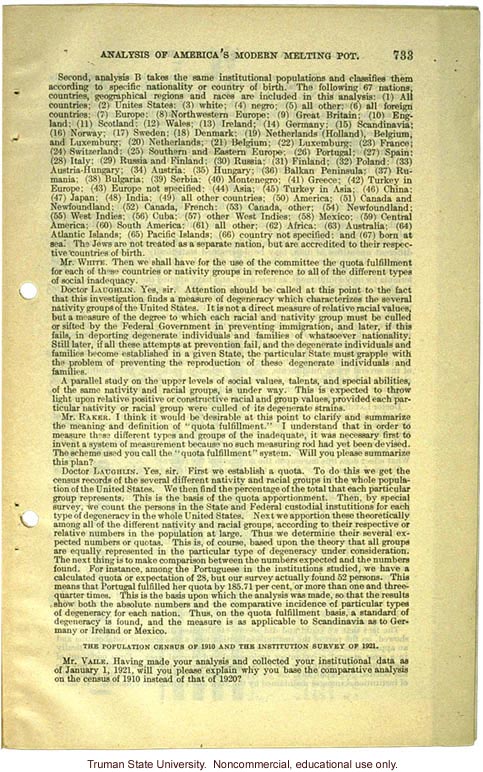Analysis of America's Melting Pot 733
Second, analysis B takes the same institutional populations and classifies them according to specific nationality or country of birth. The following 67 nations, countries, geographical regions and races are included in this analysis: (1) All countries; (2) United States; (3) white; (4) negro; (5) all other; (6) all foreign countries; (7) Europe; (8) Northwestern Europe; (9) Great Britain; (10) England; (11) Scotland; (12) Wales; (13) Ireland; (14) Germany; (15) Scandinavia; (16) Norway; (17) Sweden; (18) Denmark; (19) Netherlands (Holland), Belgium, and Luxemburg; (20) Netherlands; (21) Belgium; (22) Luxemburg; (23) France; (24) Switzerland; (25) Southern and Eastern Europe; (26) Portugal; (27) Spain; (28) Italy; (29) Russia and Finland; (30) Russia; (31) Finland; (32) Poland; (33) Austria-Hungary; (34) Austria; (35) Hungary; (36) Balkan Peninsula; (37) Rumania; (38) Bulgaria; (39) Serbia; (40) Montenegro; (41) Greece; (42) Turkey in Europe; (43) Europe not specified; (44) Asia; (45) Turkey in Asia; (46) China; (47) Japan; (48) India; (49) all other countries; (50) America; (51) Canada and Newfoundland; (52) Canada, French; (53) Canada, other; (54) Newfoundland; (55) West Indies; (56) Ccuba; (57) other West Indies; (58) Mexico; (59) Central America; (60) South America; (61) all other; (62) Africa; (63) Australia; (64) Atlantic Islands; (65) Pacific Islands; (66) country not specified; and (67) born at sea. The Jews are not treated as a separate nation, but are accredited to their respective countries of birth.
Mr. White. Then we shall have for the use of the committee the quota fulfillment for each of these countries or nativity groups in reference to all of the different types of social inadequacy.
Doctor Laughlin. Yes, sir. Attention should be called at this point to the fact that this investigation finds a measure of degeneracy which characterizes the several nativity groups of the United States. It is not a direct measure of relative racial values, but a measure of the degree to which each racial and nativity group must be called or sifted by the Federal Government in preventing immigration, and later, if this fails, in deporting degenerate individuals and families of whatsoever nationality. Still later, if all these attempts at prevention fail, and the degenerate individuals and families become established in a given State, the particular State must grapple with the problem of preventing the reproduction of these degenerate individuals and families.
A parallel study on the upper levels of social values, talents, and special abilities, of the same nativity and racial groups, is under way. This is expected to throw light upon relative position or constructive racial and group values, provided each particular nativity or racial group were culled of its degenerate straits.
Mr. Baker. I think it would be desirable at this point to clarify and summarize the meaning and definition of "quota fulfillment." I understand that in order to measure these different types and groups of the inadequate, it was necessary first to invest a system measurement because no such measuring rod had yet been devised. The scheme used you call the "quota fulfillment" system. Will you please summarize this plan?
Mr. Laughlin. Yes, sir. First we establish a quota. To do this we get the census records of the several different nativity and racial groups in the whole population of the United States. We then find the percentage of the total that each particular group represents. This is the basis of quota apportionment. Then, by special survey, we count the persons in the State and Federal custodial institutions for each type of degeneracy in the whole United States. Next we apportion these theoretically among all of the different nativity and racial groups, according to their respective or relative numbers in the population at large. Thus we determine their several expected numbers or quotas. This is, of course, based upon the theory that all groups are equally represented in the particular type of degeneracy under consideration. The next thing is to make comparison between the numbers expected and the numbers found. For instance, among the Portuguese in the institutions studied, we have a calculated quota of expectation of 28, but our survey actually found 52 persons. This means that Portugal fulfilled her quota by 185.71 per cent, or more than one and three-quarter times. This is the basis upon which the analysis was made, so that the results show both the absolute numbers and the comparative incidence of particular types of degeneracy for each nation. Thus, on the quota fulfillment basis, a standard of degeneracy is found, and the measure is as applicable to Scandinavia as to Germany or Ireland or Mexico.
The Population Census of 1910 and the Institution Survey of 1921.
Mr. Vaile. Having made your analysis and collected you institutional data as of January 1, 1921, will you please explain why you base the comparative analysis on the census of 1910 instead of that of 1920?


